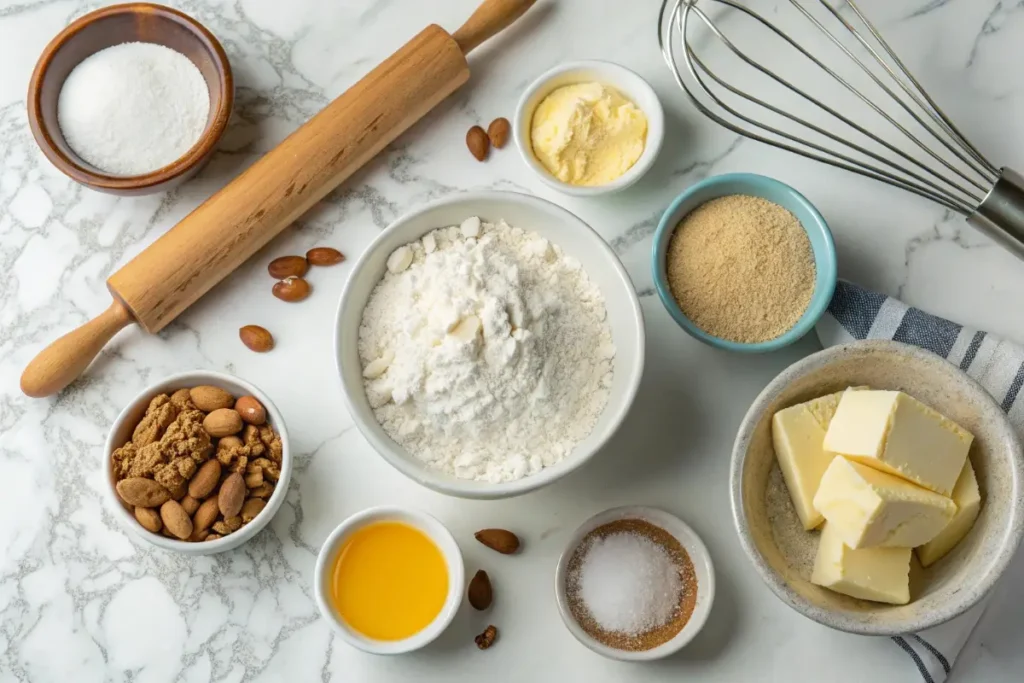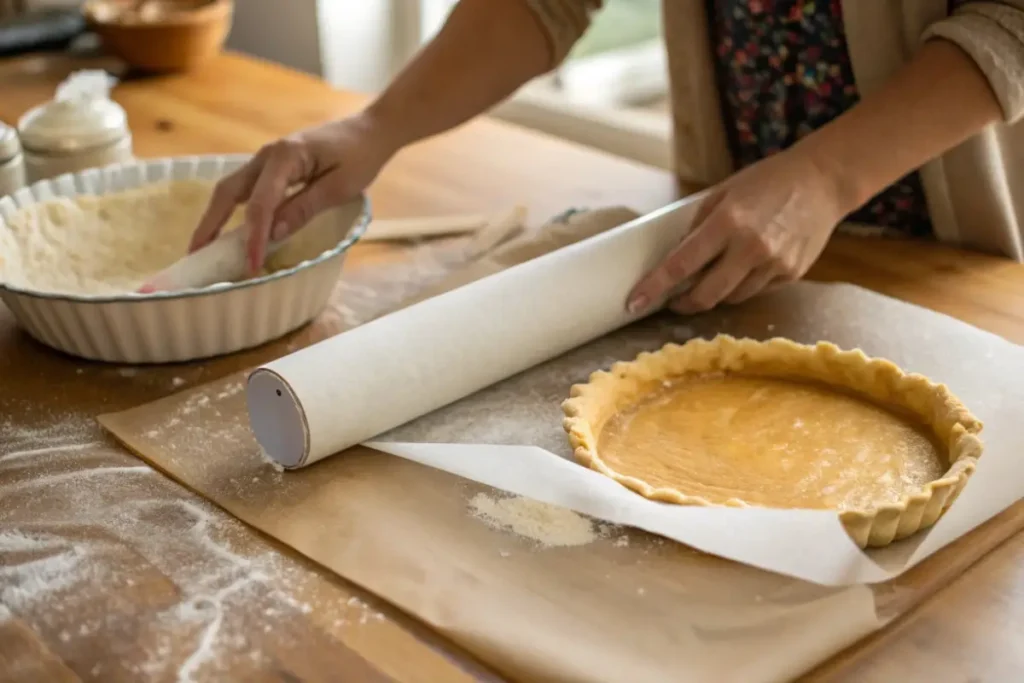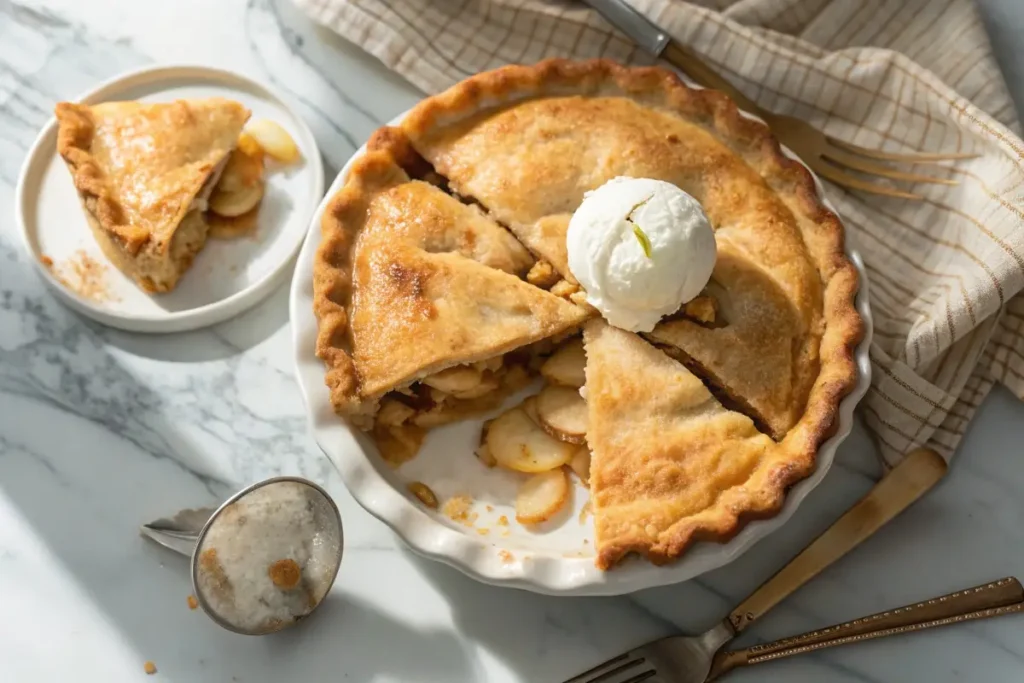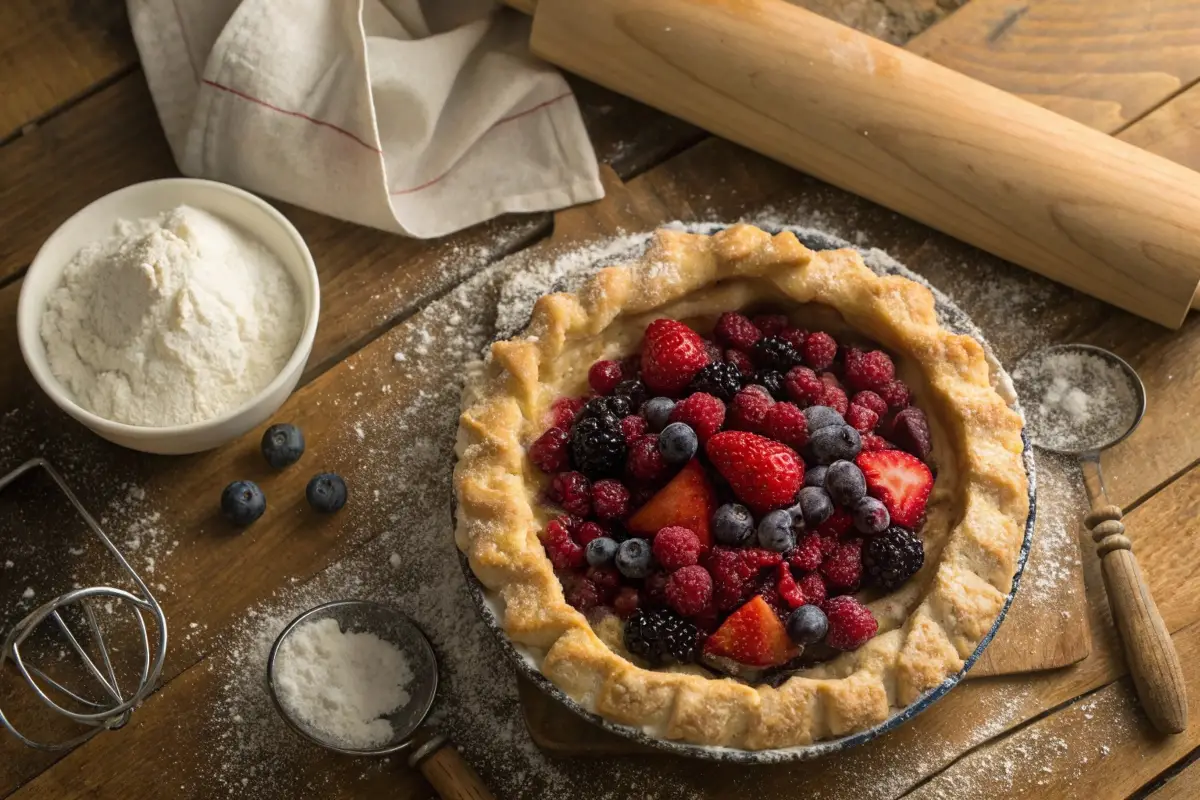A gluten-free pie crust doesn’t mean sacrificing flavor or texture. With the right ingredients and techniques, you can achieve a buttery, flaky crust that’s perfect for any pie. Whether you’re making sweet or savory recipes, this crust is ideal for those following a gluten-free diet or anyone looking to try something new. The key is choosing the right gluten-free flour blend and binding agents like xanthan gum or psyllium husk. Chill your dough properly and handle it gently to avoid cracks. From apple pies to savory quiches, a homemade gluten-free pie crust will elevate your baking game. Follow our step-by-step guide to master this recipe and enjoy delicious pies without gluten.
Gluten-Free Pie Crust: What Is It and Why Choose It?
Understanding Gluten-Free Pie Crust
A gluten-free pie crust is a pastry dough made without gluten-containing ingredients like wheat, barley, or rye. Instead, it relies on alternative flours such as almond, rice, or coconut flour. These flours, combined with binding agents like xanthan gum or psyllium husk, create a dough that’s both workable and delicious.
But here’s the kicker: while traditional pie crusts rely on gluten for elasticity and structure, gluten-free versions achieve a similar texture through careful ingredient selection and technique. The result? A crust that’s just as flaky, tender, and satisfying.
Benefits of a Gluten-Free Pie Crust
Why go gluten-free? For starters, it’s a game-changer for those with celiac disease or gluten sensitivity. Eating gluten-free can help prevent uncomfortable symptoms like bloating, fatigue, and digestive issues.
Moreover, gluten-free pie crusts often incorporate nutrient-rich ingredients like almond flour, which adds protein and healthy fats. And let’s not forget the inclusivity factor—baking a gluten-free crust means everyone at the table can enjoy a slice of pie, no matter their dietary needs.
Common Misconceptions About Gluten-Free Baking
Now, let’s bust some myths. Many people assume gluten-free baking is bland or crumbly, but that’s far from the truth. With the right ingredients and techniques, a gluten-free pie crust can rival any traditional recipe.
Another misconception? That gluten-free means less flavorful. On the contrary, alternative flours like coconut or almond can add unique, nutty flavors that elevate your pie to the next level. So, don’t let these myths hold you back—embrace the possibilities of gluten-free baking!
Essential Ingredients for a Perfect Gluten-Free Pie Crust

Gluten-Free Flours to Use
When it comes to making a gluten-free pie crust, the flour you choose is key. Unlike traditional crusts, which rely on wheat flour, gluten-free versions use a mix of alternative flours. For instance, almond flour adds richness and a nutty flavor, while coconut flour is light and absorbs moisture well. On the other hand, rice flour and oat flour (make sure it’s certified gluten-free) are great for creating a neutral base.
But here’s the thing: no single flour works perfectly on its own. That’s why many bakers blend two or more flours to get the right texture. For example, combining almond flour with a bit of rice flour can give your crust both structure and tenderness.
Binding Agents and Their Role
Without gluten, your dough might fall apart—literally. That’s where binding agents come in. Xanthan gum is a popular choice because it mimics gluten’s sticky properties, helping the dough hold together. Alternatively, psyllium husk or chia seeds can work wonders, especially if you’re looking for a more natural option.
However, don’t overdo it! Too much binding agent can make your crust gummy. A little goes a long way, so stick to the recipe measurements.
Fats for Flakiness and Flavor
Fats are the secret to a flaky, tender gluten-free pie crust. Butter is a classic choice, adding both flavor and richness. If you’re dairy-free, coconut oil or vegan shortening can be excellent substitutes.
The trick is to keep your fat cold. Why? Because cold fat creates tiny pockets in the dough, which melt during baking and create that sought-after flakiness. So, chill your butter or oil before using it!
Sweeteners and Flavor Enhancers
While not always necessary, sweeteners can add a subtle richness to your crust. Honey, maple syrup, or even a bit of sugar can enhance the flavor, especially for dessert pies.
For savory pies, consider adding herbs or spices like rosemary or garlic powder. These small touches can take your gluten-free pie crust from good to unforgettable.
Step-by-Step Guide to Making Gluten-Free Pie Crust

Preparing Your Ingredients and Tools
Before you start, gather everything you’ll need. This includes your flours, binding agents, fats, and any sweeteners or flavorings. Also, make sure you have a rolling pin, parchment paper, and a pie dish ready.
Pro tip: Measure your ingredients carefully. Gluten-free baking can be less forgiving than traditional baking, so precision matters.
Mixing and Rolling the Dough
First, combine your dry ingredients in a bowl. Then, cut in the cold fat until the mixture resembles coarse crumbs. Next, add cold water, a tablespoon at a time, until the dough comes together.
Now, here’s where things get interesting. Gluten-free dough can be a bit trickier to roll out because it’s more fragile. To make it easier, place the dough between two sheets of parchment paper before rolling. This prevents sticking and reduces the risk of cracks.
Blind Baking for Perfect Results
Blind baking—pre-baking the crust before adding the filling—is especially important for gluten-free pie crusts. Why? Because it helps prevent a soggy bottom.
To blind bake, line your crust with parchment paper and fill it with pie weights or dried beans. Then, bake it for about 15 minutes. Afterward, remove the weights and bake for another 5-10 minutes until the crust is golden.
Storing and Freezing Gluten-Free Pie Crust
If you’re not ready to bake, you can store your dough in the fridge for up to 2 days. For longer storage, wrap it tightly and freeze it. When you’re ready to use it, let it thaw in the fridge overnight before rolling it out.
Freezing pre-baked crusts is also an option. Just wrap them well to prevent freezer burn. Then, when you’re ready to bake, simply add your filling and pop it in the oven.
Top Gluten-Free Pie Crust Recipes to Try

Classic Gluten-Free Pie Crust Recipe
If you’re new to gluten-free baking, start with this simple and foolproof recipe. Combine 1 ½ cups almond flour, ½ cup rice flour, and 1 teaspoon xanthan gum in a bowl. Then, cut in ½ cup cold butter until the mixture looks like coarse crumbs. Gradually add 3-4 tablespoons ice water until the dough forms. Roll it out, place it in your pie dish, and bake as directed.
This crust works beautifully for both sweet and savory pies. Plus, it’s so versatile that you’ll find yourself using it again and again.
Vegan Gluten-Free Pie Crust
For those avoiding dairy, this vegan version is a winner. Swap the butter for ½ cup coconut oil or vegan shortening, and use chia seeds as a binding agent. Mix 1 tablespoon chia seeds with 3 tablespoons water and let it sit for 5 minutes to form a gel. Then, combine it with your flours and oil.
The result? A tender, flaky crust that’s perfect for fruit pies or quiches. And the best part? It’s completely plant-based.
Sweet vs. Savory Gluten-Free Crusts
Not all pies are created equal, and neither are their crusts. For sweet pies, add a tablespoon of sugar or honey to the dough. This subtle sweetness complements fillings like apple or pumpkin perfectly.
On the other hand, savory pies—like quiches or pot pies—benefit from a neutral or slightly herbed crust. Try adding a pinch of garlic powder, thyme, or rosemary to the dough for an extra flavor boost.
Creative Variations
Feeling adventurous? Experiment with add-ins like chopped nuts, seeds, or spices. For example, adding ½ cup finely chopped pecans to your dough can create a rich, nutty crust that pairs beautifully with pecan pie.
Or, try mixing in cinnamon or nutmeg for a warm, spiced flavor. The possibilities are endless, so don’t be afraid to get creative with your gluten-free pie crust!
Troubleshooting Common Gluten-Free Pie Crust Issues
Why is My Crust Crumbly or Dry?
A crumbly crust is a common issue in gluten-free baking. Often, it’s due to not enough moisture or binding agent. To fix this, try adding an extra tablespoon of water or a bit more xanthan gum.
Another tip? Handle the dough gently. Overworking it can make it dry and tough. Instead, press the dough together lightly until it just holds its shape.
How to Fix a Soggy Gluten-Free Crust
Nobody likes a soggy bottom! To prevent this, always blind bake your crust before adding wet fillings. Additionally, brushing the crust with an egg wash or melted butter before baking can create a barrier that keeps it crisp.
If you’re using a juicy filling, like berries, toss them with a bit of cornstarch to thicken the juices. This small step can make a big difference.
Preventing Cracks and Tears
Gluten-free dough is more fragile, so cracks can happen. To avoid this, roll the dough between two sheets of parchment paper. If it does tear, don’t panic—just patch it up with extra dough.
Another trick? Chill the dough before rolling. Cold dough is easier to handle and less likely to crack.
Overcoming Flavor Challenges
If your crust tastes bland, it might need a bit more salt or a touch of sweetness. For savory pies, try adding herbs or spices. For sweet pies, a dash of vanilla extract or a sprinkle of sugar can enhance the flavor.
Remember, gluten-free pie crusts don’t have to be boring. With a little creativity, they can be just as delicious as traditional crusts.
For more delicious recipes and baking tips, check out our other articles on gluten-free desserts and creative pie fillings. Happy baking!
FAQs
Absolutely! Gluten-free flour is the foundation of any gluten-free pie crust. However, not all gluten-free flours work the same way. For the best results, use a blend of flours like almond, rice, or oat flour. These flours, combined with a binding agent like xanthan gum, create a dough that’s easy to work with and bakes up perfectly.
The key to preventing a crumbly crust is using the right binding agent. Xanthan gum or psyllium husk helps hold the dough together, mimicking the elasticity of gluten. Additionally, make sure your dough has enough moisture—adding cold water, one tablespoon at a time, can make a big difference. Finally, handle the dough gently to avoid overworking it, which can lead to cracks.
Unfortunately, traditional Pillsbury pie crusts are not gluten-free. However, there are several brands that offer gluten-free pie crusts, such as Wholly Gluten-Free or Simple Mills. Always check the label to ensure the product meets your dietary needs.
Yes, you can! Many specialty brands and even some mainstream grocery stores now offer gluten-free shortcrust pastry. Look for options in the freezer or refrigerated section. If you prefer homemade, making your own gluten-free shortcrust pastry is easier than you might think—just follow a trusted recipe.
Conclusion – Mastering the Art of Gluten-Free Pie Crust
Creating the perfect gluten-free pie crust might seem challenging at first, but with the right ingredients and techniques, it’s entirely achievable. Whether you’re baking for dietary needs or simply exploring new flavors, a gluten-free crust can be just as delicious and versatile as a traditional one.
From choosing the right flours to mastering blind baking, every step brings you closer to pie perfection. And don’t forget—experimentation is key. Try different flours, add-ins, and flavors to find your favorite combination.
So, the next time you’re craving pie, don’t let gluten hold you back. With this guide, you’re ready to bake a gluten-free pie crust that’s flaky, flavorful, and foolproof. Happy baking!


1 thought on “Gluten-Free Pie Crust: The Ultimate Guide with Tips, Recipes, and FAQs”